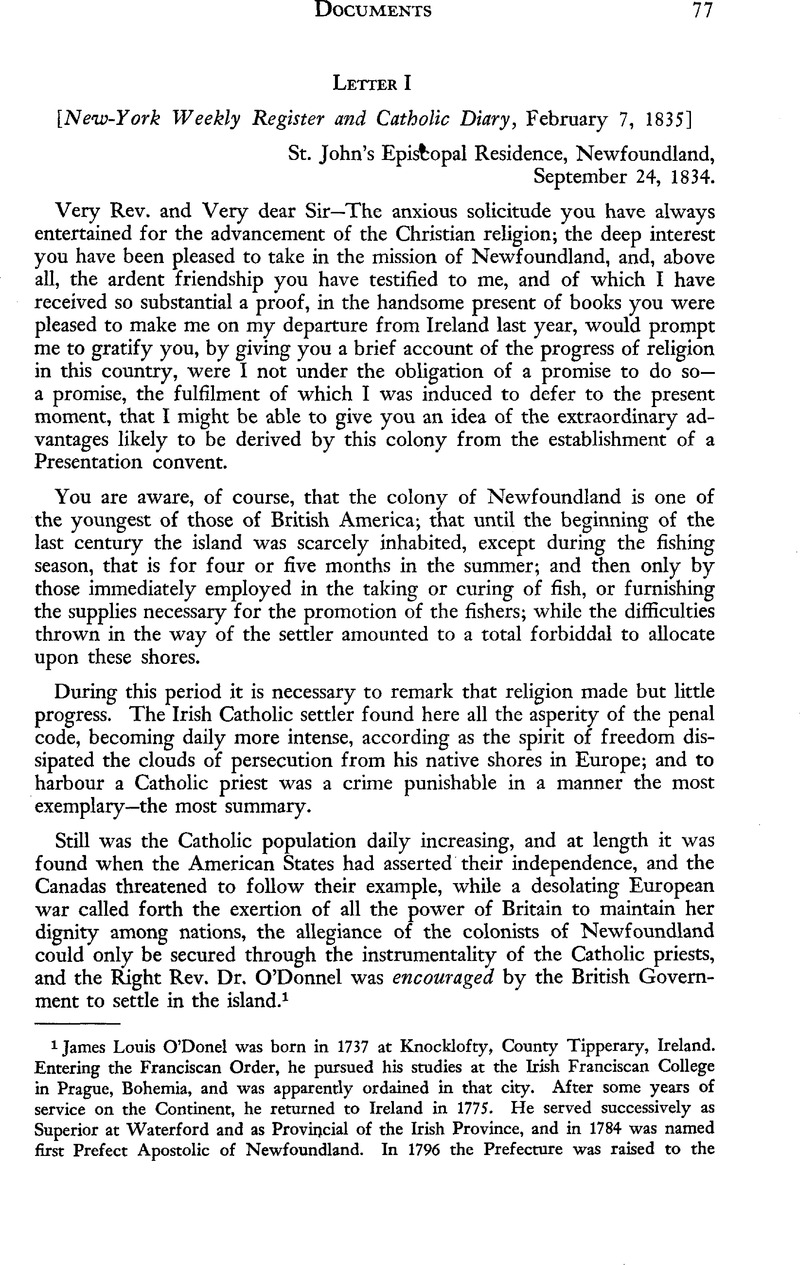No CrossRef data available.
Article contents
Letter I
Published online by Cambridge University Press: 11 December 2015
Abstract

- Type
- Documents
- Information
- Copyright
- Copyright © Academy of American Franciscan History 1950
References
1 James Louis O’Donel was born in 1737 at Knocklofty, County Tipperary, Ireland. Entering the Franciscan Order, he pursued his studies at the Irish Franciscan College in Prague, Bohemia, and was apparently ordained in that city. After some years of service on the Continent, he returned to Ireland in 1775. He served successively as Superior at Waterford and as Provincial of the Irish Province, and in 1784 was named first Prefect Apostolic of Newfoundland. In 1796 the Prefecture was raised to the rank of a Vicariate Apostolic and Father O’Donel was named Bishop of Thyatira, in partibus, and Vicar Apostolic of Newfoundland. On September 21, 1796, he was consecrated in the Cathedral of Quebec by Bishop Hubert. Bishop O’Donel divided Newfoundland into four missionary districts, formulated the first local ecclesiastical Statutes (1801) and in general laid the foundations of organized Catholic life in Newfoundland. Resigning because of ill health, he returned to Ireland in 1807, and died four years later. (Howley, op. cit., 186–224; Thomas Mullock, O.F.M., “Notizie storiche intorno a Terra Nuova nell’ America settentrionale, e intorno a’ Frati Minori che v’ introdussero il Cattolicismo …,” Operazione Dei Frati Minori circa La Propagazione Della Fede, Vol. I (maggio e giugno, 1861), 312–317, an excerpt from Mullock’s Two Lectures on Newfoundland).
2 The petition of the priests and faithful of Newfoundland to the Holy Father, November 20, 1794, asking that Father O’Donel be raised to the episcopate and Newfoundland be made a Vicariate, contains the names of three priests, Fathers Edmund Bourke, O.P., Thomas Ewer, O.F.M., and Patrick Phelan, O.F.M. Howley (op. cit., 196–199) prints this petition and also lists the names of three other priests who were in Newfoundland at the time, Fathers Michael O’Donel and John Whelan, and a Father Fitzpatrick.
3 Patrick Lambert was a native of County Wexford, Ireland. Entering the Franciscan Order, he was sent for his theological studies to the famous Irish Franciscan College of St. Isidore, in Rome. After his return to Ireland, he seems to have been employed for the most part as a professor at the friary of Wexford, and for a time served as Provincial. Appointed Vicar Apostolic of Newfoundland in succession to Bishop O’Donel, he was consecrated in the chapel of the Franciscan friary in Wexford, in April, 1806. Finding his strength unequal to the demands of his arduous charge, he resigned the Vicariate in 1817, and returned to the friary of Wexford where he died a few years later (Howley, op. cit., 236–239).
4 Thomas Scallan was, like his predecessor, a native of Wexford. His higher studies were pursued at St. Isidore’s, Rome, where, after ordination, he taught philosophy. He was assigned to the friary of Wexford in 1794, after having spent eighteen years on the Continent. At Wexford he was engaged in the role of professor until 1812, when he came to the assistance of his fellow Franciscan, Bishop Patrick Lambert, in the Newfoundland missions. Some two years later he was recalled to Ireland, but was later named Bishop of Drago, in partibus, and coadjutor to Bishop Lambert. He was consecrated on May 1, 1816, at Wexford, by Archbishop Troy of Dublin. Succeeding Bishop Lambert on the latter’s resignation the following year, he governed the Vicariate until his death at St. John’s on May 29, 1830 (Howley, op. cit., 240–254).
5 These were apparently, Fathers Thomas Ewer, O.F.M., William Hearn, Nicholas Devereux, Dennis Mackin, Patrick Cleary, and Fathers Brown, O.S.A., and Morrison (Howley, op. cit., 263). Bishop Fleming was able to add six priests to his missionary forces early in 1831: Fathers Edward Troy, Pelagius Nowlan, Charles Dalton, O.F.M., Edward Murphy, Michael Berney, and a Father Keilly (ibid., 264–267).
6 The first group of nuns to come to the assistance of Bishop Fleming, four in number under the superiorship of Sister Mary Bernard Kirwan, left the Presentation Convent, Galway, Ireland, on August 12, 1833. Sailing from Waterford on August 28, they arrived at St. John’s Newfoundland, late the following month. An account of their early labors in Newfoundland will be found in Howley, op. cit., 275–300.


